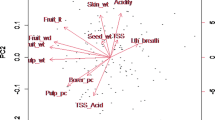Abstract
In fruit breeding, the selection is often based on individual plant performance, therefore, the expected proportion of offspring having genotypic values exceeding a given critical value (EP) was estimated for soluble solids content (SSC) in Japanese persimmon (Diospyros kaki Thunb.). A simple model was used in the study: the mean value of offspring in a full-sib family is solely determined by the regression of that on midparental value (MP) and all families have an equal within-family variance due to segregation. The population consisted of 39 full-sib families with three offspring each. Between-family variance was much smaller than within-family variance. Genetic variance for MP was much smaller than that for offspring. The EP therefore was not highly affected by the regression. Based on the parental mean performance of 35 fruits on a single tree for three years, the proportion of offspring having SSC higher than 18% was estimated as 32%, 50% and 69% for three groups of MP differing in SSC, i.e. 16.5%, 17.5%, and 18.5%, respectively. The distributions which were predicted using those results for 246 offspring from 46 families, and 86, 44, 43 and 31 offspring from four selected families, respectively, were largely consistent with those observed.
Similar content being viewed by others
References
Bell, R.L. & J. Janick, 1990. Quantitative genetic analysis of fruit quality in pear. J. Amer. Soc. Hort. Sci. 115: 829-834.
Caldwell, J.D. & J.N. Moore, 1982. Inheritance of fruit size in cultivated tetraploid blackberry (Rubus Tourn. L.) subgenus Eubatus. J. Amer. Soc. Hort. Sci. 107: 628-631.
Campbell, R.C., 1974. Statistics for biologists. 2nd ed. Baifukan, Tokyo.
Couranjou, J., 1995. Genetic studies of 11 quantitative characters in apricot. Sci. Hort. 61: 61-75.
Falconer, D.S., 1989. Introduction to quantitative genetics. 3rd ed. Longman, London.
Fanizza, G. & P. Raddi, 1973. The heritability of fruit ripening date in Vitis vinifera L. Vitis 12: 93-96.
Firoozabady, E. & H.P. Olmo, 1982. The heritability of resistance to root-knot nematode (Meloidogyne incognita acrita Chit.) in Vitis vinifera × V. rotundifolia hybrid derivatives. Vitis 21: 136-144.
Hansche, P.E., 1983. Response to selection. In: J.N. Moore & J. Janick (Eds), Methods in Fruit Breeding, pp. 154-171. Purdue Univ. Press., West Lafayette, Ind.
Hansche, P.E., V. Beres & H.I. Forde, 1972a. Estimates of quantitative genetic properties of walnut and their implications for cultivar improvement. J. Amer. Soc. Hort. Sci. 97: 279-285.
Hansche, P.E., R.S. Bringhurst & V. Voth, 1968. Estimates of genetic and environmental parameters in the strawberry. Proc. Amer. Soc. Hort. Sci. 92: 338-345.
Hansche, P.E., C.O. Hesse & V. Beres, 1972b. Estimates of genetic and environmental effects on several traits in peach. J. Amer. Soc. Hort. Sci. 97: 76-79.
Ikeda, I., M. Yamada, A. Kurihara & T. Nishida, 1985. Inheritance of astringency in Japanese persimmon. J. Japan Soc. Hort. Sci. 54: 39-45.
Kester, D.E., P.E. Hansche, V. Beres & R.N. Asay, 1977. Variance components and heritability of nut and kernel traits in almond. J. Amer. Soc. Hort. Sci. 102: 264-266.
Kitagawa, H. & P.E. Glucina, 1984. Persimmon culture in New Zealand. Science Information Publishing Centre, DSIR, Wellington, New Zealand.
Machida, Y. & I. Kozaki, 1975. Quantitative studies on the fruit quality in Japanese pear (Pyrus serotina Rehder) breeding 2. Statistical analyses of a hybrid seedling population. J. Japan Soc. Hort. Sci. 44: 325-329.
Mehlenbacher, S.A. & D.C. Smith, 1988. Heritability of ease of hazelnut pellicle removal. HortScience 23: 1053-1054.
Yamada, M., 1993. Persimmon breeding in Japan. Japan Agricultural Research Quarterly 27: 33-37.
Yamada, M., H. Yamane, K. Yoshinaga & Y. Ukai, 1993. Optimal repetition of spatial and temporal measurements for selection in Japanese persimmon breeding. HortScience 28: 838-841.
Yamada, M., H. Yamane & Y. Ukai, 1994a. Efficiency of use of control genotypes for reducing yearly fluctuations of quantitative fruit characters in Japanese persimmon breeding. Bull. Fruit Tree Res. Sta. 26: 29-37.
Yamada, M., H. Yamane & Y. Ukai, 1994b. Genetic analysis of Japanese persimmon fruit weight. J. Amer. Soc. Hort. Sci. 119: 1298-1302.
Yamada, M., H. Yamane, A. Sato, N. Hirakawa & R. Wang, 1994c. Variation in fruit ripening time, fruit weight and soluble solids content of oriental persimmon cultivars native to Japan. J. Japan Soc. Hort. Sci. 63: 485-491.
Yamada, M., H. Yamane & Y. Ukai, 1995. Genetic analysis of fruit ripening time in Japanese persimmon. J. Amer. Soc. Hort. Sci. 120: 886-890.
Author information
Authors and Affiliations
Rights and permissions
About this article
Cite this article
Yamada, M., Yamane, H., Takano, Y. et al. Estimation of the proportion of offspring having soluble solids content in fruit exceeding a given critical value in Japanese persimmon. Euphytica 93, 119–126 (1997). https://doi.org/10.1023/A:1002912325702
Issue Date:
DOI: https://doi.org/10.1023/A:1002912325702




